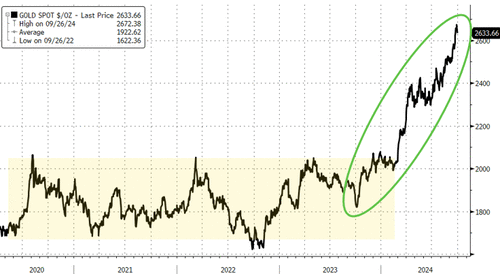‘Go For Gold’ – Goldman Sachs Raises Precious Metal Price Forecast Amid “Secret Buyers”
Despite having rallied 29% YTD and 47% since 2022, gold continues to set all-time highs, reaching $2,685/toz on Thursday.
Goldman Sachs Precious Metals analysts have raised their gold price forecast from $2,700/toz to $2,900/toz for early 2025 for two reasons.
First, our economists now look for faster declines in short-term interest rates in the West and China, and we recently showed that the gold market doesn’t fully price in the rates boost to Western ETF holdings backed by physical gold yet, which tends to be gradual.
Second, our new nowcast shows that EM central bank purchases on the London over-the-counter (OTC) market continue to fundamentally drive the rally since 2022, and we believe that these structural purchases will remain elevated.
Under Goldman’s forecast, moderating but still significant central bank purchases on the London OTC market drive about 2/3 of the expected rise of the gold price to $2,900/toz in early 2025.
The gradual rise in ETF flows following the Fed rate-cuts our economists expect drives the remaining 1/3 of price upside.
This forecast also relies on our rule of thumb that 100 tonnes of physical demand lifts gold prices by at least 2.4%, the lower bound of our regression estimate.
Following Goldman’s analysis of structurally higher demand from central banks, they developed a nowcast of central bank demand in the London OTC market, where most of these transactions take place.
Central Banks Continue to Drive the Rally Since 2022
Top of mind for investors is “Who is the ‘secret’ gold buyer?“, as gold has rallied 47% since 2022, despite rising rates which typically predict lower prices.
While the gold-price-to-rates relationship remains intact in changes, the ‘secret’ buyer has elevated prices and reset the relationship in absolute levels.
Our new nowcast shows that EM central bank gold purchases on the London OTC market continue to drive the rally since 2022. Our nowcast of central bank and other institutional demand in the London OTC market shows that purchases remained strong through July, averaging 730 tons annualized year-to-date, or about 15% of global annual production estimates.
China’s central bank, the PBoC, is a key focus for gold investors, given its reported streak of 18 consecutive months of purchases since November 2022. Our estimates of China’s institutional gold purchases in the London OTC market align with the PBoC reports, but tend to be higher, start earlier, and last longer.
While the PBoC reported no additional purchases after April, our nowcast estimates 50 tonnes of institutional purchases from China on the London OTC market in May, with no further activity in June and July.
Goldman’s nowcasting model leverages customs data and knowledge of the London OTC market, the largest hub for trading large 400 oz gold bars, which central banks and other institutions favor due to their size and lower cost per ounce, and which are typically too expensive for most retail buyers. London also provides storage for ETF holdings, central bank reserves (held in custody at the BOE), and unallocated gold accounts. Changes in these gold bar holdings in London vaults are a proxy for OTC net demand and match UK net imports, which are available by trade partners.
Our nowcasting model is the sum of two components:
(1) UK exports of gold bars to the world ex-Switzerland, and
(2) the portion of UK exports of gold bars to Switzerland we identify as central bank demand.
Goldman differentiates between UK gold bar exports to Switzerland and other countries because the former typically represent retail demand while the latter indicate central bank and institutional demand. The UK, with no (significant) gold mines or accredited refineries producing large 400 oz bars, primarily imports these large bars from Switzerland, the global refining hub, when London institutional demand or ETF inflows are high. Conversely, when demand in London is low, the UK exports large 400 oz bars back to Switzerland, where they are refined into smaller bars and sent to retail markets.
Go for Gold
We reiterate our long gold recommendation due to i) the gradual boost from lower global interest rates, ii) structurally higher central bank demand, and iii) gold’s hedging benefits against geopolitical shocks, including tariffs, Fed subordination risk, debt fears, financial, and recessionary risks.
After an already very large price rally, we end by addressing the potential factors that may moderate our base case of significant additional upside to gold prices.
These potential factors to monitor include a potential softening in our nowcast of central bank demand (for instance because of easing in geopolitical tensions), potentially lower-than-expected ETF inflows (if central banks cut rates less than expected), or a potential sharper-than-expected pullback in China’s retail demand due to price sensitivity or a sharper-than-expected gain in consumer confidence.
Tyler Durden
Mon, 09/30/2024 – 14:25




Share This Article
Choose Your Platform: Facebook Twitter Linkedin